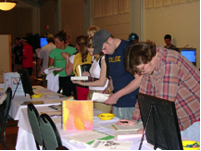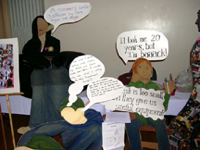12.7: The Poster Session Project
- Page ID
- 6696
At many academic conferences in a variety of different disciplines, faculty and student participants often have the option to present their research to other conference participants in a “Poster Session.” It’s similar in some ways to a science fair of the sort you might remember from junior high school: participants literally make a poster or some other sort of multi-media presentation (photographs, charts, sound recordings, video) that represent the presenter’s research.
The poster session project is different from the other alternatives to the traditional research paper I’ve discussed in this chapter because it is a supplement rather than a replacement for other research writing projects. But poster sessions are important supplements to other writing projects because they provide a different way for researchers to interact with each other and their projects, and they can work well for students in composition courses, too.
The Assignment
Based on the work you have completed with your research project, create a presentation for poster session. Your presentation could be a poster, but it does not have to be limited to just a poster. You might include other sorts of models or representations, audio files, video, etc.-- use your imagination! During our poster session, you will be expected to answer questions from others about your presentation.
Poster sessions can be small, limited to a single class, or, as the example of the Eastern Michigan University “Celebration of Student Writing” demonstrates, they can be very large. You might also supplement their poster with a short essay that explains what choices you made in putting together your presentation and why.
A Program-wide Poster Session: The Eastern Michigan University “Celebration of Student Writing”
Eastern Michigan University’s First Year Composition program has an innovative program-wide Poster Session presentation called the “Celebration of Student Writing.” Every semester, hundreds of students enrolled in first year composition courses and their instructors gather for the afternoon-long celebration. They share posters and presentations of their own and they browse and visit the posters and presentations of their classmates.

Figure \(\PageIndex{1}\) - Students visit and browse classmate’s projects at the Celebration of Student Writing.
What kinds of posters and presentations do students put together? “Sometimes, whole classes work on a single project, or a single-themed project,” said Linda Adler-Kassner, the director of the first year composition program at EMU. “Others do individual projects related to a single theme. For example, one student made life-sized cardboard people representing the communities they studied, then made speech balloons coming from them to give some details about their findings and wrote explanations about the process.”

Figure \(\PageIndex{2}\) - Cardboard cut-outs represent the members of a student’s research community.
Other projects have included the use of video, interactive games where audiences try to answer questions about a research project, models that represent some aspect of the research project, and almost every imaginable sort of poster. “We’ve even had students who dress up in costume to represent their research,” Adler-Kassner said.
The celebration is the culmination of the first year writing experience where student research focuses on issues of language and community. Students write a variety of research writing projects throughout the semester and then share their work during the celebration. And students take their posters and presentations for the celebration quite seriously. “It's one thing to come up with a catchy project-- and that takes some thinking, too-- and another to figure out how to let visitors know how much work, and what kind of work, has gone into coming to that point.”
The main audience for the celebration is other students and instructors involved in the first year composition program at EMU. But other members of the EMU community attend the celebration as well-- other students, faculty, and university administrators. And the large and diverse audience bring an added significance to the students’ research. “Students feel like people actually do care about what they write, and that the writing of others is actually interesting to them,” Adler-Kassner said. “They feel more a part of the institution because this event is attended by so many folks. They feel like they have something to say, and that people are interested.”
For more information on the Eastern Michigan University First Year Composition program’s “Celebration of Student Writing,” visit the program’s web site at www.emich.edu/english/fycomp


